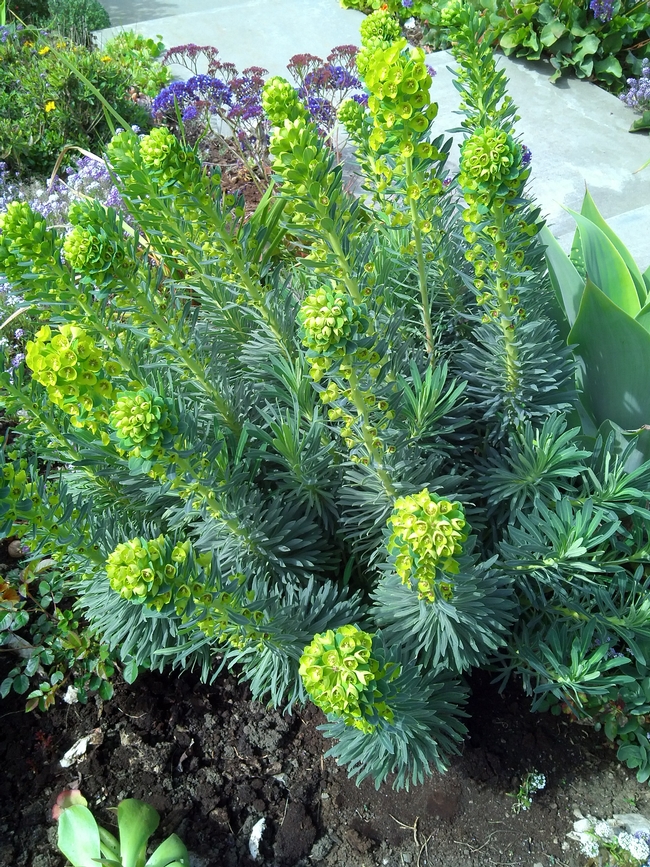- Author: Trisha Rose
Want big drama in your garden without the 'Diva' maintenance issues, what could be better? I have found a reliable stunner with the Euphorbia characias ssp. wufenii, a Mediterrenean beauty. She has found a home in my garden and has been a reliable performer. Now that we are into our early spring the very large chartreuse bracts are showing beautifully, the show will continue through June. Later I will either trim the spent blooms in early summer or leave them to dry and cut later to add to a dried flower arrangement or wreath.
Euphorbia, aka spurge, is a very large group of plants including annuals, perennials, shrubs, trees, and a few weeds. All have gray green to silvery leaves symmetrically and densely arranged on stems which produce clustered yellow to greenish yellow flowers. They tolerate a number of abuses including summer drought, heat, poor soil and my cultivar is hardy to 10 degrees. Just make sure you give reasonable drainage.
I saw a beautiful variegated cultivar this past weekend which didn’t show up in my Google search, but I did find ‘Glacier Blue’, ‘Ascot Rainbow’ and ‘Tasmanian Tiger’-which will go on my dance card for this year.

- Author: Betsy Lunde
Have any euphorbias growing at your house? You know those strange prickly, very leggy things with few leaves and maybe red or orange flowers. Euphorbia milii or Crown of Thorns probably came zipping to mind at that description. Many folks think euphorbias are only that! No so; many euphorbias are indeed prickly, but others are smooth, fleshy stemmed plants with the occasional tufts of small leaves.
Many euphorbias are listed as succulents while other varieties are not. Some are cactus-like while others such as the Christmas poinsettia, Euphorbia pulcherrima, can grow leggy up to 10 feet or taller. A number of euphorbias have a group of brightly colored bracts which are commonly referred to as the flowers; the true flowers are inconspicuous – the “flowers” of the poinsettias which we love for the showiness of flower and size are merely the bracts.
Euphorbia milii are one of my favorite house plants. If we lived in the San Diego area, these plants would be living outside in rich, porous soil in containers or in the ground itself either trained on a trellis or small frame work. The most common bract colors are red, orange, and pink. If you are lucky, you can find colors of white and pink with an orange splash. Talking with the owner of the Great Petaluma Desert some years back, I was amazed to find that he was able to propagate all colors of the crown of thorns –except the white. For some strange reason, that particular plant is very difficult to start from cuttings.
Say you are interested in euphorbias but don’t care to get full of scratches. Never fear, there are plenty of species of the family ready to call your garden home! How about Euphorbia obesa or baseball plant. Considered a succulent, it is a house plant or indoor/outdoor container plant. A solid, fleshy, gray-green sphere or short cylinder growing to 8 inches in height, with brownish striping and brown dots that resemble the stitching on a baseball. The only requirements for growth are good drainage, bright light, warmth, no sudden temperature changes, and keeping watering to a minimum. Believe me about the watering, too much and the thing keels over as though shot! I had to kill off 2 of them before getting the message.
Growing any euphorbia in the house successfully means understanding the light and temperature requirements of these plants. Grow them almost anywhere in the house and they will survive; put them in a window where there is sunlight, but no real direct sun and where they are near a window with no coverings between the plants at night. This is because they want warm days and cold nights, just like their native lands such as India and various parts of Africa.
When looking for euphorbias in the succulent section of your favorite nursery, check the plants carefully. If you don’t check, you may grab cacti in error. How to tell the difference when the desired plant has thorns? Look closely as the thorn attachment area; if you see a pad-like area (called an areole) that looks fuzzy with a number of thorns coming out, you’re holding a cactus. No pad and 1 or 2 thorns emerging at the same place, you have a euphorbia.
Go to a cactus and succulent sale or show to see the variety and wonder of the euphorbia world. I dare you to walk away empty-handed; I know I can’t!



